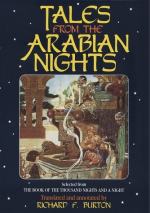Nevertheless they are not without interest, and are nearly all of obviously Oriental origin. One of the stories is a fantastic account of the Birth of Mahomet, including romantic travels largely borrowed from No. 132a. Another story is a version of that of the Seven Sleepers. Other noteworthy tales are the story of the Dervish Abounader, which resembles Nos. 193 and 216d; and the story of Naerdan and Guzulbec, which is a tale of magical illusions similar to that of Monia Emin, in the Turkish story of Jewad.
The Count de Caylus was the author of various European as well as Oriental fairy tales. Of his Oriental collection, Sir R. F. Burton remarks:—“The stories are not Eastern but Western fairy tales proper, with kings and queens, giants and dwarfs, and fairies, good and bad. ‘Barbets’ act as body guard and army. Written in good old style, and free language, such as, for instance, son petenlaire, with here and there a touch of salt humour, as in Rosanie ’Charmante reine (car on n’a jamais parle autrement a une reine, quel que laide qu’elle ait ete).’”
29, 30. Tales of the Genii (Class 3).
Written in the middle of the last century by Rev. James Ridley, but purporting to be translated from the Persian of Horam, the son of Asmar, by Sir Charles Morell.
These tales have been reprinted many times; but it is very doubtful if they are based on any genuine Oriental sources. The amount of Oriental colouring may be guessed from the story of Urad, who having consented to become the bride of a Sultan on condition that he should dismiss all his concubines, and make her his sole queen (like Harald Harfagr on his marriage with Ragnhilda), is presented to his loving subjects as their Sultana!
32. Adventures of Zeloide and Amanzarifdine.
Indian Tales, by M.
de Moncrif (Class 4).
Ordinary European Fairy Tales, with
the scene laid in the
East.
33. Nourjahad, by Mrs. Sheridan (Class 3).
An unworthy favourite is reformed by a course of practical moral lessons conveyed by the Sultan through supposed supernatural agencies. Mr. Clouston regards it as “one of the very best of the imitations of Eastern fiction. The plot is ingeniously conceived and well wrought out, and the interest never flags throughout.”
34. Pajon’s Oriental Tales (Class 5).
These demand no special
notice.
In addition to the above, the following Oriental works are mentioned in the Cabinet des Fees, but not reprinted:
1. Apologues orientaux, par
l’abbe Blanchet.
2. Melanges de litterature
orientale, par Cardonne. (Paris, 2
vols. 1770.)
3. Nerair et Meloe, roman oriental,
par H. B. Deblanes (1759).
4. Contes orientaux, par M.
de la Dixmerie.
5. Les Cinq Cent Matinees et
une demie, contes Syriens, par le
chevalier de Duclos.
6. Abassai, conte oriental,
par Mademoiselle Fault (ou
Fauques) 1752.




